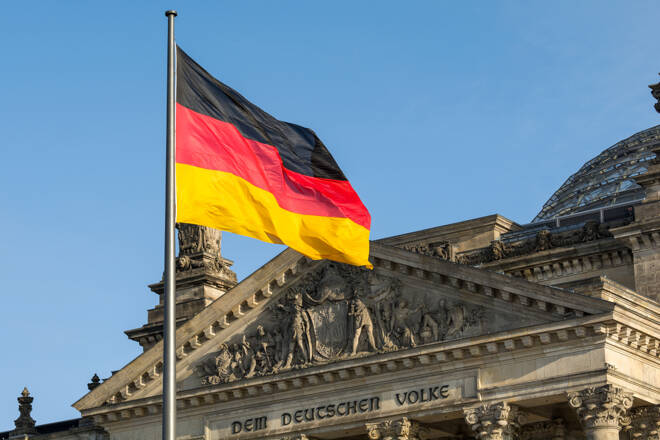Advertisement
Advertisement
Germany: Fiscal Strength and Financial Reserves Sufficient to Weather Severe Energy Shock
By:
Germany has the fiscal buffers and adequate financial reserves to weather a severe energy shock, although material damage to growth prospects could result from disruptions of Russian gas supplies.
Germany’s growth prospects have deteriorated significantly following escalation of the Russia-Ukraine war six months before. We now expect the economy to expand only 1.6% in 2022 and 1.7% in 2023, having originally anticipated more than 4% growth for this year and 3% for 2023.
Under Scope Ratings’ baseline economic scenario, sharp increases of the price of energy coupled with fresh disruptions to global supply chains result in technical recession – an economic contraction in two successive quarters – in Germany’s export-oriented economy starting Q4 2022.
Even so, Germany’s debt-to-GDP ratio will remain on course to fall to under 65% by 2027 due to low interest rates and quickly recovering tax revenue after the pandemic crisis (Figure 1).
However, there remain huge uncertainties around Russia’s approach to exporting gas to Germany and to the rest of Europe to finance its war efforts whilst simultaneously seeking to punish western neighbours for economic and military support of Ukraine and adoption of sanctions against Russia.
Figure 1: Debt-to-GDP forecasts for Germany under alternative gas shock scenarios
% of GDP
Should tensions in gas markets remain higher for longer, a more severe gas market shock in which prices were to double from Q2-2022 levels (as modelled by IW Köln) would result in deeper economic recession than under our baseline economic scenario, implying slower growth for 2022 of around 1.3%, before annual economic contraction of 0.7% in 2023. This would push debt-to-GDP to above 72% in 2022 before gradually declining thereafter.
Such a scenario is increasingly possible as upward price pressure is visible in energy futures markets in which prices have more than doubled since Q2 2022. Today’s historic peaks in European energy future contracts also reflect markets’ concerns around obstacles to Germany’s process of diversification from reliance upon gas imports.
Acute Gas Shortages Could Cause Long-term Economic Damage
Under an even more pessimistic scenario in which Russian President Vladimir Putin were to decide to maximise economic pain for Germany with periodic or permanent interruptions of Russian gas exports, resulting in acute shortages for Europe, Germany’s debt-to-GDP would rise to slightly above 75% by 2024.
This assumes GDP falling 6.6% short of that under our baseline economic scenario by 2024 and some degree of permanent degradation of German medium-run growth potential. Here, growth would rest only around 1% in 2022, before contractions of 2.1% in 2023 and 0.7% in 2024, with inflation running around 7% over 2022-24. While rising gas storage levels and falling structural demand have made such a scenario during this winter less likely, Germany’s limited gas storage capacity results in little opportunity to adjust its energy mix.
However, high fiscal buffers built up before the pandemic crisis, sufficient financial reserves and a mature fiscal policy framework support German fiscal resilience and debt sustainability even under such circumstances.
While economic damage would be unavoidable from Russian “weaponisation” of energy exports, Germany maintains ample financial capacity for further temporary relief, such as announced VAT reductions on gas in its autumn budget to support consumers should gas prices continue rising. In a pessimistic scenario, state interventions in the energy sector would increase, potentially including further demand-side measures beyond only voluntary gas savings.
Even With Fuller Storage Facilities, Reductions of Gas Consumption Prove Crucial
The German government’s efforts to secure the nation’s gas supplies before the winter continue to advance, lowering risks of even higher gas prices and possible gas shortages. Storage facilities were filled to 81% by late August and on track to meet legislative targets of 85% by 1 October and 95% by 1 November, suggesting Germany is close to the gas reserves needed to get through this coming winter.
Despite the rebound effect following the pandemic crisis, we expect structural decline of energy demand of Germany to continue over the coming years. Low-volume consumers, including households, have curtailed demand by around 6% from March 2022 after escalation of Russia’s war against Ukraine.
Industrial consumers started to reduce demand much earlier, back in August 2021, when wholesale gas prices rose sharply. This has resulted in average reductions of industrial demand of around 11%.
However, natural gas will remain a crucial energy source for Germany as it accounts for around 40% of household aggregate energy consumption, more than 30% of industry consumption and around 13% of electricity generation.
The faster Germany can replenish its gas storage levels, diversify sources of supply and lower household and industry demand for gas, the less emergency financial support from government would ultimately be required. Such moves require coordination with other EU member states, which would reassure participants in gas markets, allowing Berlin to swiftly return to a structurally balanced budget, thereby ensuring sustainability of its public finances.
For a look at all of today’s economic events, check out our economic calendar.
Eiko Sievert is a Director in Sovereign and Public Sector ratings at Scope Ratings GmbH. Jakob Suwalski, Director at Scope Ratings, contributed to writing this commentary.
About the Author
Eiko Sievertcontributor
Eiko Sievert is an Executive Director in Scope’s Sovereign & Public Sector ratings group, responsible for ratings and research on a number of public-sector borrowers.
Advertisement
